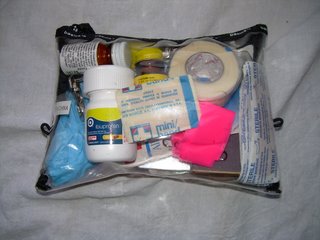Friday, September 18, 2009
Top ten things you'll forget on your next Camping trip...
Labels: camping, checklists, forgotten, hiking, prep, top ten
Thursday, October 09, 2008
Your money...and your bank
Friday, March 16, 2007
First aid and survival kit
Wednesday, March 14, 2007
Gear test: Camelbak HAWG

Camelbak H.A.W.G. -100 oz hydration day pack
 Went hiking to test this pack this week -- See related story below.
Went hiking to test this pack this week -- See related story below.The HAWG is a hydration pack --one whole compartment is for a 3l water bladder, and a drinking hose comes out of the top of the pack over the shoulder to clip to one strap for easy access. ( Not visible in pic.)
Size: 3l water bladder plus additional pockets (5) for gear.
Comfort: excellent*
Use: Day hiking, mountian biking,
Straps-- The shoulder straps looked thin, but when used with the adjustable waist belt the load is very easy to carry.
The one pictured and tested is an older model; these tend to be re-designed every few years.
Recommended?: Yes. Great for hiking and biking -- it carries alot of gear.
Labels: backpack, gear test, hydration
Sunday, March 11, 2007
Spring equipment test...surprising lessons
March gear test
Went hiking today to test out my brand new Camelback H. A.W.G. -- -- I feel the only way to know if some gear is useful (or if I know how to use it) is to actually use in the field. You can only do so much shopping and playing with it at home and then you have to test it out and see that actually works.
The things I found that had nothing to do with the pack, but were fairly important anyway ....
conditions:
Temperature 50°
wind light
six to 8 inches of melting snow
test: 50 minutes of hiking in a large park
The first thing I found out is the can't have too many AA batteries. I wanted to try my GPS which powered up when I checked it, but when I took it outside of course it was out of juice.
The second thing I found out is that snow melts. Although this should be self-evident but half a dozen places under the snow there are six-inch puddles. This led me to discovery of:
Third -- -- my hiking boots are not waterproof. They are not 'kind of 'waterproof, they're not water resistant they're not water light or anything like it. Soaked in right through.
And of course I was wearing cotton socks.
Fourth when hiking on hilly snow water muck ice, a walking stick would have been very useful.
(I'll review the Camelback later.)
Saturday, January 27, 2007
Water treatment options
 Don't drink the water!
Don't drink the water!At least untreated, that is. Here are some ways to treat found water.**
The top red is just a metal water bottle -- you can bring tap water with you
On the left is a filter bottle with iodine -- great and convient, but yucky taste
In the blue bag is a 'first need' water filter
the tiny bottle is iodine tablets -- add them and wait 30 minutes -- also has a bad taste
on the right is a platypus foldable bottle.
the little silver dot is a quarter, for scale
the mug is a sierra cup, in case you wanted to treat ( boil) small amounts of water.
( it is possible, just really slow.)
I'm considering offering a class just on finding/ treating water.
( ** Any water found in the wild is questionable and you should treat it.)
Various survival kit containers
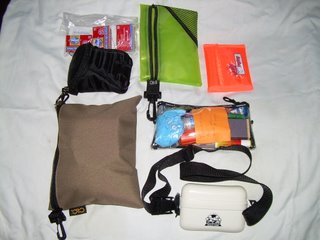
A variety of kit ideas and sizes.
From upper left, going across: plastic ziploc bag, camera bag with belt loop, a zippered pencil case, nylon wallet, brown fabric case (sold in tool stores) a plastic make up pouch and a "beach safe" on a belt.
So you can carry as much or as little as you want. The idea with this slide is to show students a variety of ways to carry your FAK/survival items.
Note: the brown case and clear make-up case are shown --with contents-- elsewhere on this blog.
Labels: homemade gear, kits, planning
Big mug
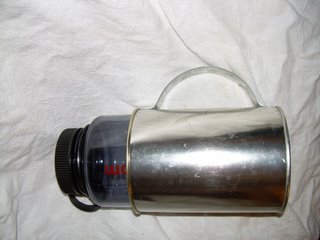
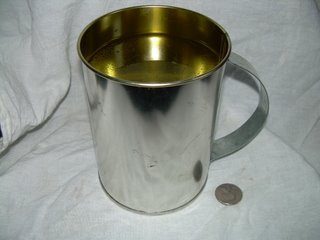 This is a BIG mug that fits over the end of a Naglene (or similar) water bottle. If necessary, I could boil water in the thing. The quarter is for scale.
This is a BIG mug that fits over the end of a Naglene (or similar) water bottle. If necessary, I could boil water in the thing. The quarter is for scale.Another option is the "space saver cup" that also fits over the end of a water bottle $6-8.
A backpacking kit (in progress) UPDATE 2009

Here is a kit I might carry on an overnight backpacking trip.
Its got the basics covered with:
Water: bags, tablets
Shelter: Space blanket, garbage bags(x2)
Fire: Matches(x2)
Signaling: Mirror, whistle
Tools: Knife, wire saw, compass on wrist band
First aid: sanitary napkin for stopping big bleeding) band-aids, gloves
Comfort items: Kleenex
NOTES: It has no food, as that attracts bears. The knife is a swiss army model with a locking blade. Looking it over, I would add:
Flagging tape,
sunblock chapstick,
Tyneol and pepto meds,
safetypins
cordage (probably 50# test fishing line)
Duct tape 3 m wound on a pencil stub
This is in adition to the regular backpacking gear -- tent, sleeping bag, food, stove, pack, etc.
{ In response to a comment; the gear in in the origional packages for photo purposes only. When I pack it along its out of the packages.}
Labels: DIY, homemade gear, survival kit
Hiking kit
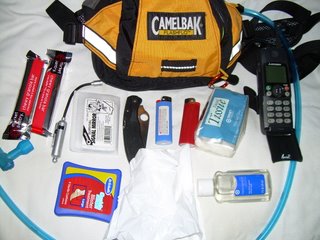
My day hiking kit.
This is what I carry for "a walk in the park." It all fits in the camelbak 'flashflo'waistpack. The little bendy thing in a flashlight, and in the center are two 13 gallon trash bags. The most important item? The (charged) cell phone.
This kit is evolving; I have added 15' of parachute cord, and will add a whistle and small compass. Outside of this I am usually wearing a hat for sun protection and a seasonal jacket.
TRO
comments welcome
Thursday, April 20, 2006
Check-lists
1. Home preparation
2. Training.
3. personal kit
4. information collecting
-Good stuff to know:
-Peoples contact information*
-The weather/ news
-Alternate routes home
5. official lists
